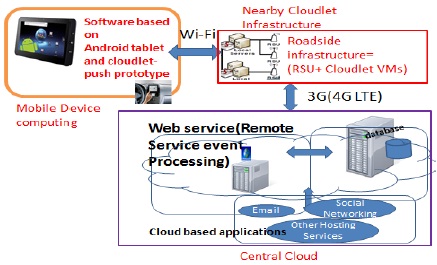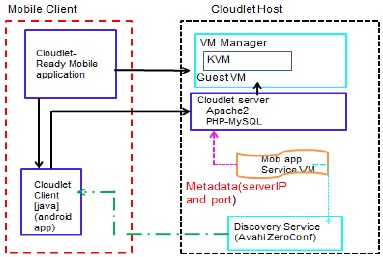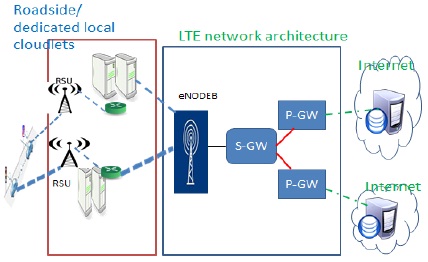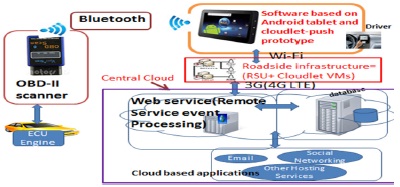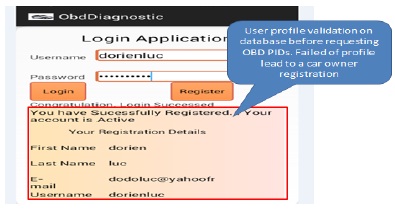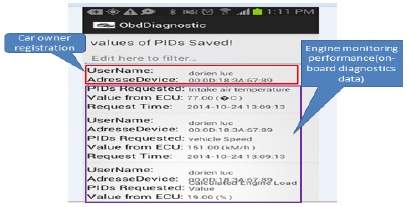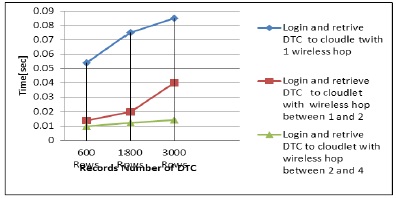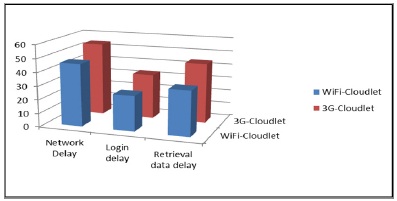



자동차 진단 데이터의 양이 증가함에 따라 자동차 에코시스템의 액터는 스마트 자동차에서 수집된 데이터에 따라 새로운 서비스를 시뮬레이션 하거나 설계하기 위하여 실시간으로 분석을 해야 하는 어려움에 직면하게 된다. 본 논문에서는 자동차에서 생성된 막대한 양의 자동차 내장 진단 데이터를 처리하고 분석하는데 필수적이고 심오한 해석학을 제시하는 빅 데이터 솔루션에 관한 연구를 하였다. Hadoop 및 그 에코시스템은 자동차 소유자에 대한 새로운 서비스 제공을 위해 자동차 에코시스템의 액터에 의해 사용될 수 있는 막대한 데이터 및 전달된 유용한 결과를 처리하기 위해 개발된 것이다. 지능형 교통시스템이 안전성 보장, 속도로 인한 사고로 입는 상해 및 충돌의 비율 감소 등에 관여함에 따라, 자동차 진단 데이터 기반의 빅 데이터 솔루션 개발을 통해 향후 실시간 결과 감시, 여러 스마트 자동차에서의 데이터 수집, 수집된 데이터에 대한 신뢰성 있는 처리 및 용이한 저장을 실현화하게 된다.
A MCC(Mobile Cloud Computing) has been defined in different form of views in the literature [1]. The MCC is defined as a combination of cloud computing, wireless communication facilities, portable computing devices, and mobile Web and location aware-based services [2]. The implementation of mobile cloud application can be accomplished when the computation and storage are made available from the cloud but mobile applications affront some challenges such as latency, user interactivity [2].
Microsoft MAUI noted that some applications might encounter workable difficulties from nomadic smartphones, due to the high latency mobile cloud infrastructure connection [3]. Existing cloud computing tools tackle only specific problems such a flexible VM (Virtual Machine) management [4]. Virtualization lacks capabilities for enabling the application to scale efficiently because of new applications components which are raised to be configured on demand. To effectively leverage the full activity of cloud computing, developers of mobile app shall adopt an application architecture designed with the cloud in consideration. There is also a need to enable safer interaction that defines a communication interface between mobile devices and application in cloud. It is feasible to address a mobile device’s resource and carry out pre-processing via a nearby cloudlet. A cloudlet is a new architectural element that arises from the convergence of mobile computing and cloud computing [5]. A cloudlet can be viewed as a "data center in a box" whose goal is to "bring the cloud closer"[6]. Our architecture based on cloudlet Push [7] aims to produce a high-scalable vehicle‘s on-board diagnostics processing.
This paper addresses those issues previously described by providing not only mobile cloud computing-cloudlet architecture but also a dedicated platform that relies on using virtual private mobile networks to provide reliable connectivity through Fig. 1 Mobile Cloud ComputingCloudlet architecture.LTE(Long Term Evolution) wireless communication.
Ⅱ. PROPOSED MOBILE CLOUD COMPUTING-CLOUDLET ARCHITECTURE
Fig.1 shows the proposed architecture for implementing mobile app. The architecture proposed is a hierarchical that consists of 3 layers: Mobile device computing, nearby cloudlet infrastructure, and central cloud.
2.1. Mobile device computing within mobile app based on Cloudlet push prototype
A cloudlet is defined as a trusted, resource-rich computer or cluster of computers that is well connected to the Internet and available for use by nearby mobile devices [5]. The cloudlet push prototype consists of five major components as shown in Table 1: KVM, Cloudlet Server, discovery service, cloudlet client, Vehicle on board diagnostics analysis application.
[표 1.] 주요구성요소와 cloudlet-push의 설명
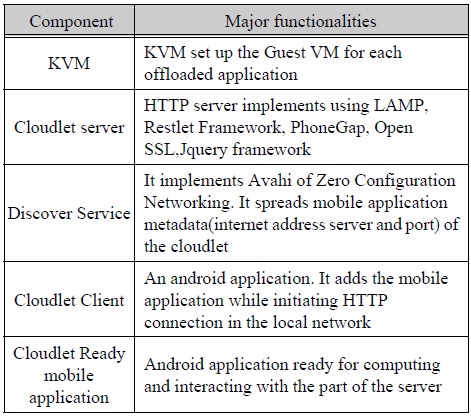
주요구성요소와 cloudlet-push의 설명
Fig.2 summarizes the model of the mobile device cloudlet Push prototype. The initial prototype in implementation of a face-recognition application proposed in [8] has been taken as a reference to design smartphone-cloudlet push prototype model in this paper
2.2. Nearby cloudlet infrastructure
The nearby cloudlet infrastructure is quietly composed of roadside units and dedicated cloudlets servers. The roadside proposed model is mainly composed of a cloudlet based VM.
The ownership of the cloudlet in the proposed architecture is decentralized in various local businesses and allowed sharing resources with few users at a time.
Moreover, those cloudlets are connected to cloud computing. The major point on which cloudlet is highly preferable is it self-managed, soft state such as cache copies of data. Thus, a cloudlet’s loss or destruction does not suspend deployment of cloud-based applications to the customer.
The central cloud can includes either dedicated servers in cloud providers services data centers or servers in the Internet. It is responsible for complex computation, data storage, and global decisions by performing the following services :real time secure access, integration, and monitoring.
Ⅲ. EXPECTATION OF VIRTUAL PRIVATE MOBILE NETWORK TO PROVIDE RELIABLE CONNECTIVITY
The LTE architecture consists of a RAN(Radio Access Network), cell which is managed by an eNodeB(Evolved NodeB), and the EPC (Evolved Packet Core) consisting of S-GWs(Serving GateWays), P-GWs (Packet data network GateWays)[9]. In the EPC, the MME(Mobility Management Entity) finds out the corresponding subscriber information S-GWs, then S-GW establishes a logical point-to-point link to P-GWs which finally transmits over the Internet to the target cloud provider server. In this paper, we consider a mobile network infrastructure that take up advances in virtualization to dynamically establish customizable, resource isolated, and end-to-end communication [10].
In this case, the resources in a physical mobile network should be appropriately and dynamically allocated, isolated, customizable. In a roadside environment, there are diverse cloudlet VMs since a backend-system or cloud computing providers provide services to several neighboring roadside units, dedicated cloudlet based VMs and users simultaneously. The virtualization and partitioning mechanisms are designed such that the packet from two cloudlets based VM on roadside environment will be routed by one physical eNodeB, then sharing one S-GWs, finally the packet from two cloudlets will be convoyed through different P-GWs to target cloud computing server as is shown in Fig.3. Here, we formulate the resource isolated among the cloudlet based VMs for virtual private mobile network resources creation.
Ⅳ. IMPLEMENTATION AND ITS RESULTS
4.1. Design of Remote Vehicle Diagnostic mobile app
By considering that vehicles rely on mobility, we can develop its capability and smoothness to support several missions. This system design consists of a set of sensors which perform the basic data acquisition of the system. Among these sensors are generally embedded in the gathering units, such as GPS(Global Positioning System) receivers in smartphone, the OBD(On Board Diagnostics) scanner tool which is connected to the car‘s standard connector generally located near the driver seat. The self-diagnostic and reporting capabilities are treated by the on-board diagnostic system. The data from in vehicles sensors units are passed to the Mobile device such as smartphone, then forwarded to a set of Road Side Units (RSU) and dedicated cloudlets to cloud computing providers over a set of access points of communication. he design of this architecture is shown in the Fig.4.
4.2. Wireless Connection environment
The fact is to set up an environment that will help to manage communication between a mobile device and the cloudlet for discovering a nearby mobile device interacting with the cloudlet. In this paper we chose Wi-Fi because it the most used technology for establishing communication between a mobile device and a nearby cloudlet. We chose to set up a Wireless Access Point (WAP) at the cloudlet so that the mobile app based android can interact the cloudlet. The Wireless Access Point is a NETIS WF2419 300Mbps Wireless N Router which is a combined wired and wireless device.
4.3. implementation of some functions of the remote vehicle diagnostic mob application based android
Fig.5 and Fig.6 show login before requesting engine performance, retrieving DTC(Diagnostic Trouble Codes) values uploaded into database respectively
To test the implementation model, we performed several process using our android application known as Remote vehicle diagnostic to both the cloudlet and the central cloudlet. We perform some tasks such as car owner Login before using the software and retrieval OBD-PIDs (on-baord diagnostics parameters Id) stored on the cloud. During the implantation, we present data analysis for the measurement latencies known to as delay for data upload from the android application, the amount of power consumed during the running tasks tested as described early in this section, the amount of time needs to achieve predefined tasks. For the measurement of latencies, we are interested on the average latency as well as the variance in latency, as a function of two tasks tested such as login process and retrieval data stored into the database. It is important to remind that wireless access point approach uses frequency hopping to hand out transmission, so in our analysis of latencies communication, we have also considered the number of hops in route.
Regarding latency measurement, our major goal is to study the ability of cloudlet based Virtual machine to improve the response time while a process is being executed on the cloudlet for example when the car owner keeps saving on his or her mobile device file which contains a list of DTC downloaded from the cloud.
The nomadic smartphones cloudlet-based approach provides a much smaller interaction time which as shown in only if the number of cloudlet hops is more than 2 as shown of Fig. 7 . The Fig.8 reports the result of the latency measurement. The network delay was measured with values between 46 and 54 milliseconds. The login task on the cloudlet was reported a delay between 26 and 33 milliseconds, retrieval stored data was evaluated with a value between 33 and 44 milliseconds. The network delay averages was measured just below 50 milliseconds. According to the result from the implementation, it seems that Wi-Fi is preferable over the use of 3G, since Wi-Fi uses less power than 3G communication. Also it gives us about 22 milliseconds for both tasks running (login delay and retrieval data delay).
The processing delay shows surely that using cloudlet-based virtual machines is entirely recommended in processing with less delay using Wi-Fi to cloudlet connection using Wireless Access Point.
In this paper, we have argued that vehicle owners, authorities and businesses have to take up cloud computing, cloudlets, and nomadic smartphones to enable telematics services and others value-added services. We present a mobile cloud computing which enables data remote vehicle diagnostic service, event processing through virtual machine based cloudlets. After designing the mobile cloud computing-cloudlet architecture, it is very important to understand how an LTE- and the proposed architecture in this paper may fit together for mobile cloud computing and mobile applications. Therefore, developers of applications require understanding the design of a typical LTE network by focusing on how a large virtual private mobile network that embraces the concept of virtualization and partitioning technology in order to share physical mobile network should carry out data from mobile device to back-end systems. A remote vehicle diagnostics mobile application attests the concept of vehicle to cloud capable of collecting diagnostics data. Experimental results showed that the proposed model cloudlet architecture environment achieved the goals in reducing the communication latency when the nomadic smartphones process tasks that take place remotely. Our next purpose is to implement a full prototype to evaluate others value-added services.
